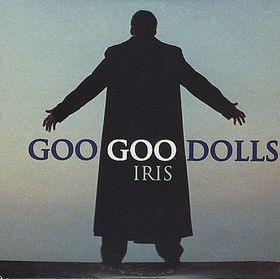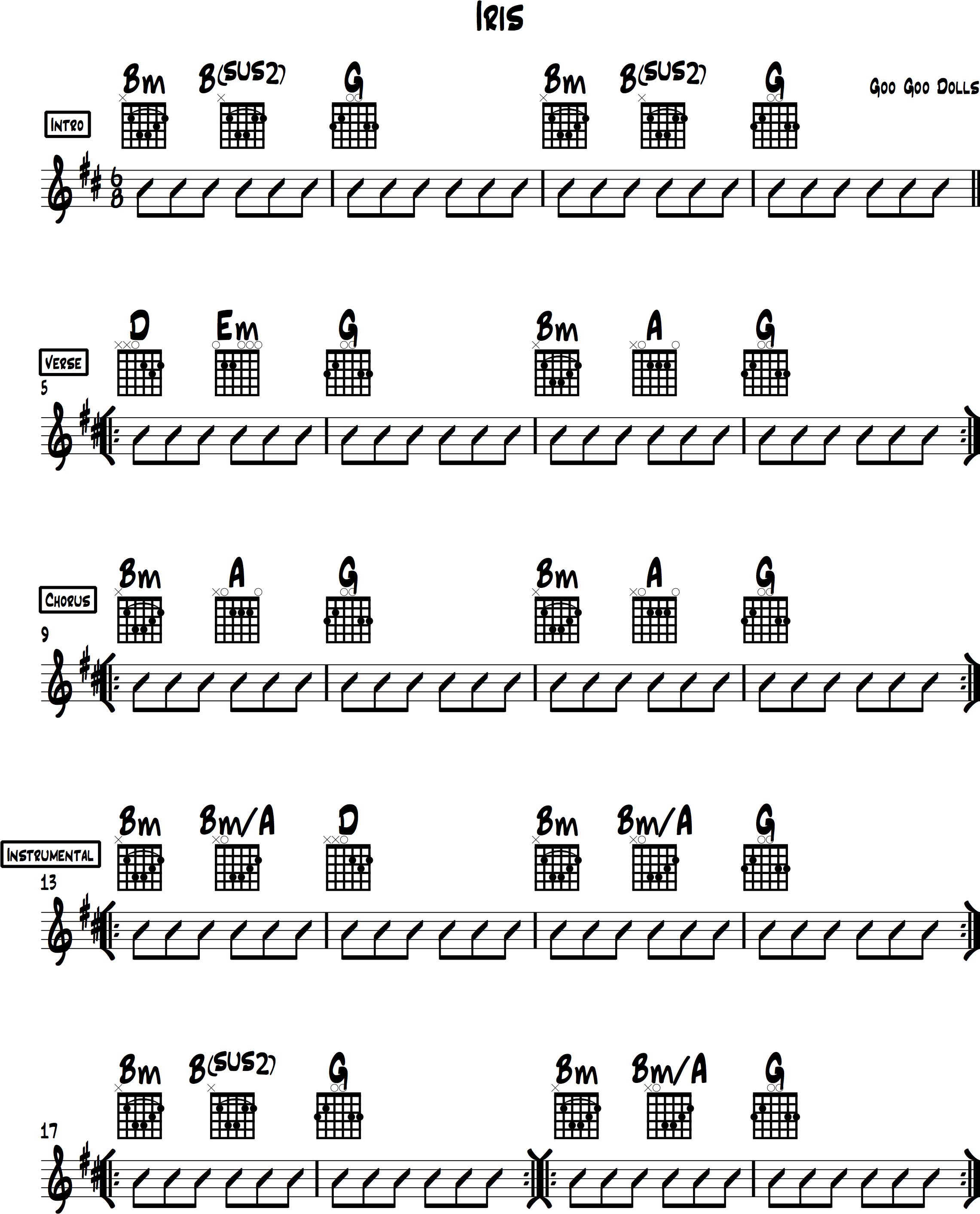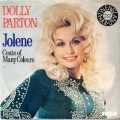Easy Guitar Chords Arranged for Beginners
American alternative rock band, the Goo Goo Dolls, originally recorded “Iris” for the soundtrack of 1998 film City of Angels, the song was later included on the band’s sixth album Dizzy Up the Girl. The song has contributed greatly to the band’s success. Iris chords feature an unusual guitar tuning in which most of the strings are tuned to D, giving the guitar a chorus-like effect. It also has an unusual time feel switching between 4 and 3.
“Iris” has become one of the biggest rock hits from the 90s and it’s also one of the biggest crossover hits in the history of popular music. The song has achieved success in modern rock, pop and adult contemporary genres, reaching number one on all of these radio formats and it was the most played song of 1998.
Useful links:
Song Specs
 Title: Iris
Title: Iris
Artist: Goo Goo Dolls
Songwriters: Johnny Rzeznik
Album: Dizzy Up the Girl
Key: Bm
Tempo: 144
Chord Progression: Bm–Bsus2–G–D–Em–A
Accompaniment Technique: First-Position Chords, Barre Chords and Fingerstyle Strumming
Playing Tips
Here are some helpful tips to keep in mind that will help you learn the tune faster while giving you some ideas for how to approach performing it. I provided some useful links above and I’ll take you through the Iris chords, accompaniment patterns, song form and a chord chart. Everything you need to get started playing this tune.
Iris Chords
| Chords | Bm | Bsus2 | G | D | Em | A |
| Progression | i | Isus2 | bVI | bIII | vi | bVII |

“Iris” is a soulful acoustic number. We can use the acoustic guitar part from the studio recording as a template that we’ll base our strumming approach on. However, there are some tricky parts that need to be ironed out and I needed to make some concessions for our arrangement purposes.
Here are a few of the issues:
- The alternating time signatures (from 4 to 3 and 3 to 4).
- The unorthodox tuning (we’ll be playing in standard tuning).
- The mandolin parts that are featured in the instrumental sections.
With these things in mind, let me give you an overview of the song.
This song is mainly in the key of B natural minor and two-bar chord riffs are the main components of the song. The verse does hint at D major for the first half of the progression and the instrumental section has been abridged for our purposes. Also, I’ve adjusted the time feel in the intro and instrumental sections to make it less confusing (I’ll explain this and demonstrate it in the video).
We’re also gonna approach this from a strumming standpoint. We’ll be using a pick and I believe John Rzeznik and Robby Takac (the guitarists on this song) both use picks. Feel free to use your fingers to strum and they do provide more sound options. More importantly, I encourage you to approach the song however you feel most comfortable. These are just my suggestions.
Accompaniment Techniques
I generally use a few basic approaches to acoustic-guitar playing. They’re mostly based on a fingerstyle technique that I’ll describe below and can be applied pick-style playing. But, the basic idea is that my thumb plays the bass note and my index and middle fingers brush the top part of the chord.
Here’s the basic technique that I use:
- Bass Chord: Separate the thumb and fingers to create more of a rhythmic feel. Aim to use the thumb on the downbeat and then freely strum with the index and middle fingers. I’ll explain this in more detail after we look at the next section.
Basic Fingerstyle Technique
Iris chords are perfect for beginning fingerstyle players to strum. The right hand is notated as follows:
- P = Thumb
- I = Index
- M = Middle
- A = Ring
Next, we’ll assign the right-hand fingers to certain strings:
- The Thumb (P) plays the bass note:
- 6th string for G and Em
- 5th string for Bm, Bsus2 and A
- 4th string for D
- The Index (I) is assigned to the 4th string.
- The Middle (M) is assigned to the 3rd string.
- The Ring (A) is assigned to the 2nd string.
- The I-M-A fingers move up a string set for the Dm and D7 chords. Or, you could assign the I-M-A fingers to the 3rd, 2nd and 1st strings right from the beginning.
This is the essence of fingerstyle playing, assigning fingers to specific strings. This way, you don’t need to look at the right hand while playing. Once you get used to it, you can “feel” where you are.
The Boom-Chick Technique
“Iris” uses an alternate (down and up) strumming technique and I’ll first describe it with a pick. Amongst guitarists, this technique is referred to as the boom-chicka pattern. Here’s the breakdown:
- The “boom” is the bass (lowest note of the chord) played with a downstrum
- The “chicka” is the higher part (the top 2 or 3 strings) of the chord also played with alternating strums (down followed by up)
- Downstrum on “chick” and the upstrum on “a”
There’s a boom-chick technique that is the basic version of the boom-chicka. And, the boom-chick only uses downstrums: bass-chord, bass-chord; or, boom-chick, boom-chick.
When hitting the bass (boom), you aim for the lower part of the chord (or the bottom three strings). Then, for the chord (chick), aim for the higher three strings.
Also, you don’t need to strum too hard. Brush the strings and try to recreate that bouncy feel that is a key component of the song.
The Fingerstyle Version of the Boom-Chicka Technique
The thumb (or P) plays the bass note (boom) and the I-M fingers brush down and up on the higher three strings creating the chick-a.
- “Boom, chicka, chicka” is the feel that you’re aiming for.
Chord Chart
I’ve included a chord chart, which is a simple road map that shows you:
- The overall arrangement of the song.
- A section by section breakdown of the song.
- Each chord and how long to play it for.
If you don’t read music, please don’t be intimidated. This is a cheat sheet that can help you get through the tune quickly and easily. I find it indispensable for learning songs. Also, I can hand it to a seasoned musician and they can follow along without any problems.
Song Form
- Intro: 4-bar section with a 2-bar chord riff that repeats; Bars 1, Bm to Bsus2; Bar 2, G for a full measure; and repeat.
- Verse: 4-bar section; Bars 1, D to Em; Bar 2, G for a full measure; Bar 3, Bm to A; Bar 4, G for a full measure.
- Chorus: 4-bar section with a 2-bar chord riff that repeats; Bars 1, Bm to A; Bar 2, G for a full measure; and repeat.
- Instrumental: 16-bar section (I’ve adjusted it to make it easier to follow. You can also play B–Bm/A (or A)–G and repeat that.
Once you become familiar with chord charts, you’ll gonna never want to go back. It’s just easier to see where you’re going when you have a map. And, it’s especially helpful when you’re not familiar with the song or there’s a section of the song that you don’t remember (Bridges and Interludes are notorious for surprising players and derailing a song’s performance). So, heads up, this tune has an Instrumental section.

Wrap-up
I hope that you’ve enjoyed learning Iris chords as much as I did in preparing this lesson for you. During the intro for this piece I mentioned that the Goo Goo Dolls achieved an incredible amount of crossover success with this tune. I encourage you to listen to check out other genres. Maybe you’ll discover some new music that will inspire you and motivate you.
Thanks for hangin’ with me and I’ll see you next time.







